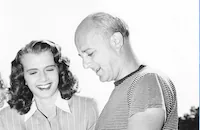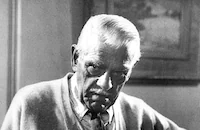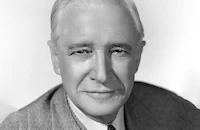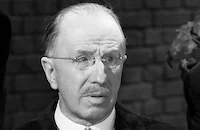The Raven
Brief Synopsis
Cast & Crew
Louis Friedlander
Karloff
Bela Lugosi
Lester Matthews
Irene Ware
Samuel S. Hinds
Film Details
Technical Specs

Synopsis
When Jean Thatcher is severely injured in an automobile wreck, her father, a judge, and her fiancé, Dr. Jerry Halden, request the eccentric but brilliant Dr. Richard Vollin to operate. Although retired to Hillview Heights, Vollin finally agrees to perform the surgery and falls in love with Jean. Vollin's hobby is the work of Edgar Allan Poe, and for him, Poe's poem "The Raven" is a talisman, symbolizing death, which for Vollin is the only certain part of life. Judge Thatcher realizes Vollin's infatuation with his daughter when, after she is recovered, she performs a dance interpretation of Poe's poem. The two men quarrel when the judge forbids Vollin to see his daughter, and Vollin argues that he needs her. Edmond Bateman, a murderer and thief who is trying to reform, demands that Vollin change his facial structure. Bateman is not only trying to escape the police, but he also believes that his ugly appearance causes him to do ugly deeds. Vollin cruelly alters Bateman's facial muscles to make him blind in one eye and truly hideous, then demands that Bateman serve him and promises to repair the damage in a later operation. Jean and Jerry accept Vollin's invitation to a weekend party, despite the judge's opposition. The guests, including Colonel Bertram Grant and his wife, are horrified at the sight of Bateman, who is introduced as a victim of Arab torture. During the party, Vollin shares his interpretation of "The Raven." According to Vollin, Poe, a man of genius like himself, decided to impress on others the torture he was feeling when deprived of his beloved "Lenore." Later, Jean apologizes to Bateman for being afraid of him, and Bateman tries to warn her of Vollin's evil intent. Vollin tells Bateman to take the sleeping judge into the basement and place him on a full-size model based on Poe's story "The Pit and the Pendulum." An elevator then lowers Jean's room into the torture chamber. When Jerry discovers that her room has disappeared, he awakens one of the other guests, Geoffrey, and his girl friend to assist him. Vollin closes metal shutters over the windows, however, and locks them in. Vollin then places Jean and Jerry into a shrinking room, so that in death they will be inseparable. This cruelty is more than Bateman will allow, and though shot by Vollin, he saves Jean and Jerry and Vollin dies in the shrinking room. After escaping, the others release the judge before the swinging pendulum blade can strike him.

Director

Louis Friedlander
Cast

Karloff

Bela Lugosi
Lester Matthews
Irene Ware

Samuel S. Hinds
Spencer Charters
Inez Courtney

Ian Wolfe
Maidel Turner
Cyril Thornton

Arthur Hoyt
Nina Golden
Raine Bennett
Joe Haworth
Bud Osborne
Al Ferguson
Madeline Talcott
John Hale

Walter Miller
Anne Darling
Mary Wallace
June Gittleson
Crew
Albert Akst
Scott R. Beal
Stanley Bergerman
David Boehm
Albert S. D'agostino
George Denormand
David Diamond
Guy Endore
Florence Enright
Florence Enright
John P. Fulton
Ed Haskett
Moree Hering
Theodore Kosloff
Gilbert Kurland
Carl Laemmle
Otto Lederer
John Lynch
Clarence Marks
Monte Montague
Vic Noerdlinger
Maurice Pivar
Hazel Rogers
Dore Schary
M. Simmons
Charles Stumar
Jim Tully

Film Details
Technical Specs

Articles
The Raven (1935)
In spite of its title, The Raven isn't really an attempt to film Edgar Allan Poe's famous poem. Instead, it's an homage to the famous writer that captures the spirit of his dark, morbid prose (Roger Corman also directed a film with the same title in 1963 that served as an affectionate horror parody and starred Vincent Price, Boris Karloff, Peter Lorre and Jack Nicholson). The story opens with a car crash involving the famous dancer Jean Thatcher (Irene Ware) who is saved from certain death by the emergency surgery of Dr. Richard Vollin (Lugosi). In gratitude for saving her life, Jean surprises the doctor with an inspired dance tribute to his favorite author, Edgar Allan Poe, but unwittingly creates a "monster." Vollin becomes obsessed with Jean -she's the embodiment of "Lenore" (the heroine of Poe's poem) - and he'll do anything to prevent her upcoming marriage to fiance Jerry (Lester Matthews). When Jean's father, Judge Thatcher (Samuel S. Hinds), forbids Vollin to see his daughter anymore, the surgeon plots a diabolical revenge with the assistance of Edmond Bateman (Karloff), an on-the-lam criminal who has made a regrettable pact with Vollin.
Shot on a fifteen day shooting schedule with a total budget of $109,750, The Raven represents the only time Lugosi predominated over his co-star in a horror film, despite his second billing to Karloff. In their later films together such as Son of Frankenstein (1939) and The Body Snatcher (1945), Karloff always had the more important role but not this time. Admittedly, Karloff wasn't too fond of The Raven, remarking at one point: "Here was an attempt to pile on the thrills without much logic." Yet, despite a rumored rivalry between the two horror stars, Karloff and Lugosi became good friends on the set of The Raven (One playful behind-the-scenes publicity still shows the two actors taking a nap after reading the screenplay).
When The Raven was released, it came under heavy fire from film censorship boards in various states who took offense at the film's emphasis on torture and sadism. For instance, New York and Ohio wanted to omit scenes of Judge Thatcher being menaced by the swinging pendulum and some of Vollin's dialogue like "Torture waiting, waiting. It will be sweet...." Of course, these are the scenes from The Raven that are best remembered by horror fans. Vollin's torture chamber, Bateman's hideously distorted face, and rooms in the surgeon's mansion that function as elevators and death traps (the walls can crush people) give the movie its horrific edge. There are also memorable stylistic touches such as a mirror-shattering sequence (a precursor to a similar scene in Orson Welles' The Lady From Shanghai, 1948) and a startling hand-held camera shot as Bateman enters Vollin's home for the first time and meets his future tormentor.
At the same time, parts of The Raven are unintentionally funny. Both Lugosi and Karloff overact here in a broad, theatrical style and Irene Ware's interpretative dance modeled on Poe's work is a hoot. But these flaws are also part of the film's charm and it's quite easy to enjoy The Raven for its sheer melodramatic excess alone.
Producer: David Diamond
Director: Louis Friedlander
Screenplay: David Boehm
Art Direction: Albert S. D'Agostino
Cinematography: Charles Stumar
Editing: Albert Akst
Music: Gilbert Harland
Cast: Boris Karloff (Edmond Bateman), Bela Lugosi (Dr. Richard Vollin), Irene Ware (Jean Thatcher), Lester Matthews (Dr. Jerry Holden), Samuel S. Hinds (Judge Thatcher), Inez Courtney (Mary Burns), Ian Wolfe ("Pinky" Geoffrey).
BW-62m. Closed captioning.
by Jeff Stafford

The Raven (1935)
Quotes
Your monstrous ugliness breeds monstrous hatred. Good! I can use your hate.- Dr. Richard Vollin
Trivia
Notes
Edgar Allan Poe's poem "The Raven" first appeared in book form in The Raven and Other Poems (Nov 1845). Contemporary reviews claimed that the film was based not only on the title source, but also on Poe's "The Pit and the Pendulum," "Buried Alive," "The Gold Bug" and other tales. The New York Times review remarked, however, that it took "amazing effrontery" for Universal to claim that the film was inspired by Poe's classic short stories, as the plot resembled none. Louis Friedlander, who shortly after the release of this film changed his name to Lew Landers, made his feature directing debut with The Raven, after having made five serials. "The Raven" was adapted in 1963 by American International Pictures, with Roger Corman directing Vincent Price, Peter Lorre and Boris Karloff (see AFI Catalog of Feature Films, 1961-70; F6.4029).














